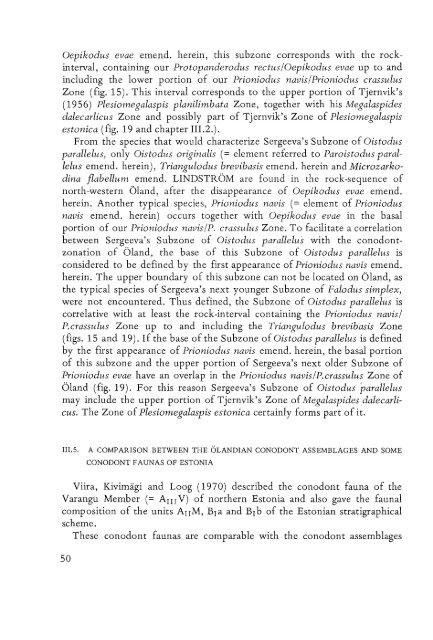UTRECHT MICROPALEONTOLOGICAL BUllETINS
UTRECHT MICROPALEONTOLOGICAL BUllETINS
UTRECHT MICROPALEONTOLOGICAL BUllETINS
You also want an ePaper? Increase the reach of your titles
YUMPU automatically turns print PDFs into web optimized ePapers that Google loves.
Oepikodus evae emend. herein, this subzone corresponds with the rockinterval,<br />
containing our Protopanderodus rectus/Oepikodus evae up to and<br />
including the lower portion of our Prioniodus navis/Prioniodus crassulus<br />
Zone (fig. 15). This interval corresponds to the upper portion of Tjernvik's<br />
(1956) Plesiomegalaspis planilimbata Zone, together with his Megalaspides<br />
dalecarlicus Zone and possibly part of Tjernvik's Zone of Plesiomegalaspis<br />
estonica (fig. 19 and chapter III.2.).<br />
From the species that would characterize Sergeeva's Subzone of Oistodus<br />
parallelus, only Oistodus originalis (= element referred to Paroistodus parallelus<br />
emend. herein), Triangulodus brevibasis emend. herein and Microzarkodina<br />
flabellum emend. LINDSTROM are found in the rock-sequence of<br />
north-western Oland, after the disappearance of Oepikodus evae emend.<br />
herein. Another typical species, Prioniodus navis (= element of Prioniodus<br />
navis emend. herein) occurs together with Oepikodus evae in the basal<br />
portion of our Prioniodus navis/P. crassulus Zone. To facilitate a correlation<br />
between Sergeeva's Subzone of Oistodus parallelus with the conodontzonation<br />
of Oland, the base of this Subzone of Oistodus parallelus is<br />
considered to be defined by the first appearance of Prioniodus navis emend.<br />
herein. The upper boundary of this subzone can not be located on Oland, as<br />
the typical species of Sergeeva's next younger Subzone of Falodus simplex,<br />
were not encountered. Thus defined, the Subzone of Oistodus parallelus is<br />
correlative with at least the rock-interval containing the Prioniodus navis/<br />
P.crassulus Zone up to and including the Triangulodus brevibasis Zone<br />
(figs. 15 and 19). If the base of the Subzone of Oistodus parallelus is defined<br />
by the first appearance of Prioniodus navis emend. herein, the basal portion<br />
of this subzone and the upper portion of Sergeeva's next older Subzone of<br />
Prioniodus evae have an overlap in the Prioniodus navis/P.crassulus Zone of<br />
Oland (fig. 19). For this reason Sergeeva's Subzone of Oistodus parallelus<br />
may include the upper portion of Tjernvik's Zone of Megalaspides dale carlicus.<br />
The Zone of Plesiomegalaspis estonica certainly forms part of it.<br />
III.S. A COMPARISON BETWEEN THE OLANDIAN CONODONT ASSEMBLAGES AND SOME<br />
CONODONT FAUNAS OF ESTONIA<br />
Viira, Kivimagi and Loog (1970) described the conodont fauna of the<br />
Varangu Member (= AlII V) of northern Estonia and also gave the faunal<br />
composition of the units AIIM, BIa and BIb of the Estonian stratigraphical<br />
scheme.<br />
These conodont faunas are comparable with the conodont assemblages
















